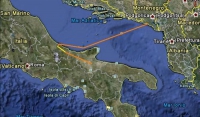An undersea transmission cable potential threat to smelters

12 October 2016, 08:54
Tags: cable
Smelters in South Eastern Europe, before all KAP in Podgorica, Montenegro and Aluminij d.d. in Mostar, Bosnia and Herzegovina, are potentially at risk of experiencing higher electricity costs after an undersea transmission cable becomes functional in late 2018.
On October 4, ground works officially started on Montenegro’s coast, near the town of Budva (cape Jaz), to prepare infrastructure for an undersea electricity transmission cable to connect southern Italy and Montenegro by end of 2018.
Over € 800 million worth of cable will sprawl for 390km under the Adriatic Sea, while an additional 55 km will be on shore (25km in Montenegro).
A high-voltage electric interconnection, 1000 MW /500 KV will enable electricity exports (such as ‘’green’’ energy) from Montenegro and surrounding countries: Croatia, Bosnia & Herzegovina, Serbia, and Albania to Italy. Electricity prices are substantially in Italy now are substantially more expensive than in Montenegro and surrounding countries (especially the ‘’green’’ energy).
At the same time an optical cable for telecommunications is being laid down.
In 2011, not long after the project was agreed and the contract signed, Serbia signed an agreement with Italy to export its own hydro-electricity through the cable.
The major investor is Italian company Terna, which has also declared an interest in laying two more undersea cables, which will connect Italy with Croatia and Albania in the future. The minority shareholder is Montenegro’s public electricity transmission company, CGES.
So far, 136 km of the cable has been laid down from the Italian side, starting near city of Pescara.
Parallel to this, CGES is building a 400 KV substation and a 400 KV overhead transmission cable connecting the coastal substation (converter station) with the one in the town of Pljevlja, in northern Montenegro. Last week Montenegro’s government and representatives of the Czech company Škoda Praha (part of CEZ Group), signed a contract to build a new thermo power plant in Pljevlja (a second part to an existing one), with a projected power of at least 254 MW and investment worth €324 million.
It is expected that this investment will spur further investments in Montenegro and the region, before all in hydro power plants and renewable energy sources (wind, sun).
It is certain even now that all surplus electricity in the region will be exported as ”green” energy to Italy, at least in the first several years. Unless the two main smelters have long term contracts (which do not exist at the moment) they may face significant tariff cost increases to already high electricity prices: KAP currently pays € 40 per MWh while Aluminij Mostar pays even more at € 42 / MWh. It is reasonable to expect that all electricity distributors /suppliers in the region will prefer to export electricity to Italy at up to 100 % higher price, instead of supplying aluminium smelters and other industries.




 Previous
Previous